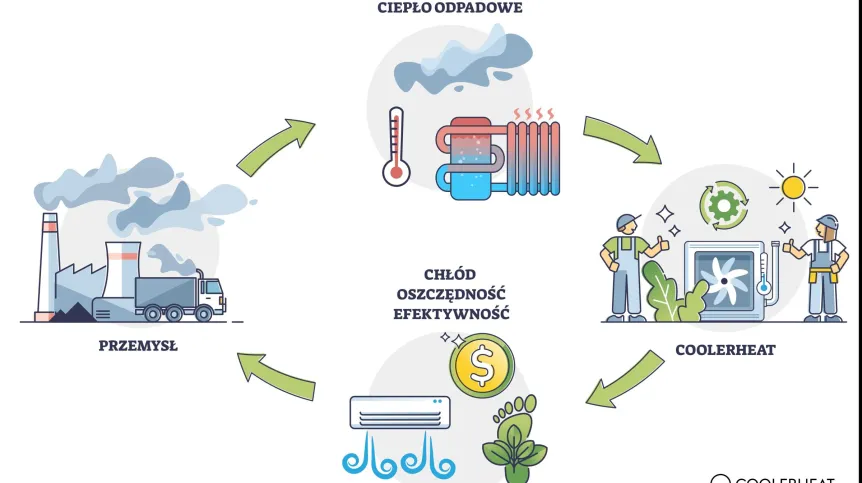
Dr. Łukasz Witanowski from the Institute of Fluid-Flow Machinery of the Polish Academy of Sciences in Gdańsk proposes to use waste heat to produce cooling. The scientist is working on a system that will, for example, enable heating networks to generate cooling for air conditioning systems in the summer.
According to the leader of the COOLERHEAT project implemented under the NCBR Leader programme, increasing temperatures cause an increase in the demand for cooling also in industry, which at the same time emits huge amounts of waste heat into the environment. Paradoxically, this contributes to a further increase in greenhouse gas emissions and exacerbates the problem of global warming.
Waste heat is unused energy released into the environment. Scientists distinguish three main levels of waste heat: low-temperature (below 100 degrees Celsius), medium-temperature and high-temperature (from 300 degrees Celsius). In industry, as much as 42 percent global share is low-temperature waste heat, 20 percent is medium temperature and 38 percent is high temperature waste heat.
WASTE HEAT BRINGS NEW POSSIBILITIES
'Existing technologies allow us to use waste heat to produce electricity, cooling and heat, but they are often limited by high investment and operating costs, low efficiency and limited functionality, especially with heat sources below 80 degrees Celsius. COOLERHEAT enables operation at low temperatures with satisfactory efficiency, and it is a financially advantageous system', says Dr. Łukasz Witanowski.
His COOLERHEAT system consists of an ORC (organic Rankine cycle) system connected to a VCC (vapour compression cycle) system using a turbo-compressor. The system uses waste heat to generate mechanical power in a turbine, which drives the refrigeration system compressor.

'The proposed solution opens new prospects for the effective use of waste heat, enabling a more sustainable approach to the management of energy resources in various industrial sectors', says Dr. Witanowski.
HEATING PLANTS WILL COOL US IN SUMMER
The COOLERHEAT system can be adapted to the various needs of the company that will implement the solution. 'The key component of the system, a special turbo-compressor, can be designed for a wide range of applications - from large industrial capacities to solutions designed for smaller entities. This flexibility opens the door to innovative applications, such as the use of heating networks in the summer', says Witanowski.
He explains that networks that operate at a significantly reduced capacity in summer will be able to effectively generate cold for air conditioning systems using network heat. According to the scientist, this will benefit end users and network operators.
'We are introducing a technology to the market that is not only consistent with ecological trends and energy efficiency, but also provides real financial benefits for a wide range of users. The enthusiasm for such technological solutions is fully justified, as they combine innovation with practical applications, opening new opportunities for sustainable development’, Witanowski says.
According to the scientist's estimates, the use of waste heat, which has so far been treated as wasted energy, will allow companies to turn losses into profits. Enterprises will increase energy efficiency and reduce their carbon footprint. For the environment, this means lower greenhouse gas emissions and less energy used for cooling.
THREE YEARS OF EXPERIMENTS
The scientist explains that in order for the system to be implemented in practice, the project must achieve its 'milestones'. The first is to optimally design the system to work in various operating conditions. The next challenge will be to develop a turbo-compressor design characterized by high operational reliability, adjustability and compact size. After constructing the prototype machine, scientists will conduct experimental tests to ensure the system reliability and safety.
'The COOLERHEAT project must pass rigorous tests in a wide range of operations, which will confirm that it meets high industrial standards and various operational conditions', says Witanowski. The success of the project is to be ensured by a multidisciplinary team of nine people specialising in thermodynamic calculations of thermal cycles, design of thermal machines, dynamic calculations of rotating systems, strength calculations, machine learning, optimisation of thermal processes, 3D printing, automation and thermal measurements.
'The team members took part in many projects related to machines and thermal cycles carried out at the Institute of Fluid-Flow Machinery of the Polish Academy of Sciences. We have planned to use a number of advanced methods to bring the team closer to achieving the project's goals, including the use of modern optimisation algorithms, machine learning techniques for data analysis and creation of predictive models, and verification of the results using a variety of independent computational codes', says Dr. Witanowski.
The project will last three years, and experimental research will constitute a significant part of it. The results and progress of ongoing research can be followed on the COOLERHEAT project website.
PAP - Science in Poland, Karolina Duszczyk
kol/ agt/ kap/
tr. RL













